Net-Zero and Multimodal Mobility Project Through PV-Battery-EV in the Amazon
Abstract
1. Introduction
1.1. General Considerations
1.2. Motivations and Contributions
- The need to assess the operational feasibility of electric mobility under tropical and isolated conditions;
- The opportunity to utilize PV generation and battery energy storage to supply autonomous electric transport systems;
- The importance of developing monitoring and data acquisition tools that integrate heterogeneous devices and platforms;
- The potential to create replicable models for sustainable transport in the Amazon and other developing regions.
- To characterize the energy architecture of the SIMA project, encompassing PV generation, energy storage systems, and electric mobility modes.
- To analyze operational and simulated data from electric buses, the CEAMAZON hybrid microgrid, and the electric catamaran.
- To evaluate and compare the real and estimated energy balances of the system, identifying periods of surplus or deficit and quantifying the overall renewable contribution.
- To assess the project’s overall energy efficiency and propose strategies, such as PV capacity expansion or module upgrading, to ensure long-term sustainability.
2. State of the Art
2.1. Energy Storage Systems
- Centralized systems, where control is exercised by system operators, utilities, or independent aggregators;
- Plant-integrated systems, coupled with generation units to smooth production profiles and regulate power injection;
- Behind-the-meter systems, located close to the load and directly managed by end users within the distributed generation domain.
- Ensuring continuity of supply during grid outages;
- Optimizing the utilization of locally generated solar energy;
- Reducing peak demand and associated tariff costs; and
- Providing operational flexibility in energy use throughout the day.
2.2. Behind-the-Meter Storage System
- The ability to maintain supply during power outages is imperative.
- The objective is to optimize the self-consumption of photovoltaic energy, with the subsequent storage of surplus energy for subsequent use.
- A decline in demand was observed during peak tariff hours.
2.3. Storage Systems in Electric Vehicles
2.4. Electric Vehicles
2.4.1. Charging Stations
- Level 1: Slow charging up to 2 kW, typically with 120 V AC outlets; full charge in 8–14 h.
- Level 2: Intermediate charging between 208 and 240 V AC and up to 20 kW; full charge in 4–8 h. This level is suitable for both residential and public charging.
- Level 3: Fast charging using DC at 400 V or higher, with power above 60 kW; 80% charge in 15–30 min.
2.4.2. Charging Management
- the State of Charge (SoC) of the battery;
- the available solar energy;
- the electricity price on the grid;
- the demand profile of the building or facility.
3. Subject of Study: SIMA Project
3.1. Mirante Do Rio
3.2. CEAMAZON Hybrid Mini-Grid
3.3. Electric Mobility
4. Methodology
4.1. Data Collection and Processing Analysis
- Photovoltaic Systems: Variables related to voltage, current, and generation power are correlated with environmental data (irradiance and temperature) to analyze performance during dry and rainy periods in the Amazon.
- The following variables were measured in the study: distance traveled, energy consumed per trip, and number of days of operation. The latter two variables were measured in EBs. The monitoring process encompassed the two models in operation on the campus: the highway model (Belém-Castanhal) and the urban model. Equation (3) shows the expression used to calculate the autonomy of buses.
- The present study investigates the energy consumption of the CEAMAZON Building, with a view to integrating this with photovoltaic generation and storage. Furthermore, the study assesses the seasonality of demand associated with the UFPA academic calendar.
- Variations in EBs energy consumption according to the academic calendar and route type;
- The impact of Amazonian seasonality on the performance of the PV systems;
- Energy demand patterns of the CEAMAZON building; and
- Strategies for using the ESS to reduce costs and enhance reliability.
4.2. Electric Boat Simulation
- Onboard photovoltaic generation;
- A 615 Ah battery bank; and
- A propulsion system composed of two 12 kW squirrel-cage induction motors.
- Evaluation of the actual energy performance of the transportation modes and the building;
- Estimation and comparison of the boat’s consumption through simulation; and
- Identification of months in which total energy demand could potentially exceed generation.
5. Results and Discussion
5.1. Electric Bus
5.2. Electric Boat
5.3. SIMA Project
5.3.1. 1º Case: Real Scenario at UFPA
5.3.2. 2º Case: Estimated Scenery
6. Conclusions
Author Contributions
Funding
Data Availability Statement
Acknowledgments
Conflicts of Interest
References
- United Nations. Cumbre de las Naciones Unidas Sobre el Desarrollo Sostenible Naciones Unidas; United Nations: Rome, Italy, 2015.
- Tabora, J.M.; Paixão Júnior, U.C.; Rodrigues, C.E.M.; Bezerra, U.H.; Tostes, M.E.d.L.; Albuquerque, B.S.d.; Matos, E.O.d.; Nascimento, A.A.d. Hybrid System Assessment in On-Grid and off-Grid Conditions: A Technical and Economical Approach. Energies 2021, 14, 5284. [Google Scholar] [CrossRef]
- Chong, L.W.; Wong, Y.W.; Rajkumar, R.K.; Rajkumar, R.K.; Isa, D. Hybrid Energy Storage Systems and Control Strategies for Stand-Alone Renewable Energy Power Systems. Renew. Sustain. Energy Rev. 2016, 66, 174–189. [Google Scholar] [CrossRef]
- Tabora, J.M.; Daniel Melgar-Dominguez, O.; Amador, H.; de Lima Tostes, M.E.; de M.C., C.C.M.; Bezerra, U.H.; Soares, T.M. Energy Flexibility: A Systematic Review with a Perspective from Latin America. In Proceedings of the 2024 IEEE 42nd Central America and Panama Convention (CONCAPAN XLII), San Jose, Costa Rica, 27–29 November 2024; pp. 1–6. [Google Scholar]
- International Energy Agency. Global EV Outlook 2025—Analysis; IEA: Paris, France, 2025.
- Lobato, E.; Prazeres, L.; Medeiros, I.; Araujo Felipe and Rosario, D.; Cerqueira, E.; Tostes, M.; Bezerra, U.; Fonseca, W.; Antloga, A. A Monitoring System for Electric Vehicle Charging Stations: A Prototype in the Amazon. Energies 2023, 16, 152. [Google Scholar] [CrossRef]
- 4E Technology Collaboration Program of the International Energy Agency. Product Policy Framework for Demand Side: Case Studies; IEA: Paris, France, 2025.
- Zhang, S.; Hu, W.; Du, J.; Cao, X.; Bai, C.; Liu, W.; Wang, D.; Chen, Z. Hierarchical Distributionally Robust Scheduling Strategy for Distributed Energy Systems in the Energy-Sharing Environment. Appl. Energy 2025, 388, 125639. [Google Scholar] [CrossRef]
- Chen, X.; Liu, Y.; Fan, N.; Wu, L. An Operating Profit-Oriented Medium-Term Planning Method for Renewable-Integrated Cascaded Hydropower. Energy 2025, 338, 138686. [Google Scholar] [CrossRef]
- Tariq, A.H.; Amin, U. Peer-to-Peer Multi-Energy Trading in a Decentralized Network: A Review. Renew. Sustain. Energy Rev. 2025, 208, 114969. [Google Scholar] [CrossRef]
- Wang, L.; Wang, Z.; Li, Z.; Yang, M.; Cheng, X. Distributed Optimization for Network-Constrained Peer-to-Peer Energy Trading among Multiple Microgrids under Uncertainty. Int. J. Electr. Power Energy Syst. 2023, 149, 109065. [Google Scholar] [CrossRef]
- Wang, D.; Fan, R.; Yang, P.; Du, K.; Xu, X.; Chen, R. Research on Floating Real-Time Pricing Strategy for Microgrid Operator in Local Energy Market Considering Shared Energy Storage Leasing. Appl. Energy 2024, 368, 123412. [Google Scholar] [CrossRef]
- Hasan, M.K.; Mahmud, M.; Ahasan Habib, A.K.M.; Motakabber, S.M.A.; Islam, S. Review of Electric Vehicle Energy Storage and Management System: Standards, Issues, and Challenges. J. Energy Storage 2021, 41, 102940. [Google Scholar] [CrossRef]
- Wang, Y.; Wang, X.; Shao, C.; Gong, N. Distributed Energy Trading for an Integrated Energy System and Electric Vehicle Charging Stations: A Nash Bargaining Game Approach. Renew. Energy 2020, 155, 513–530. [Google Scholar] [CrossRef]
- Wang, Z.; Hou, H.; Zhao, B.; Zhang, L.; Shi, Y.; Xie, C. Risk-Averse Stochastic Capacity Planning and P2P Trading Collaborative Optimization for Multi-Energy Microgrids Considering Carbon Emission Limitations: An Asymmetric Nash Bargaining Approach. Appl. Energy 2024, 357, 122505. [Google Scholar] [CrossRef]
- Yang, X.; Zhou, F.; Xu, R.; Zhong, Y.; Yu, J.; Yang, H. Optimal Guidance Mechanism for EV Charging Behavior and Its Impact Assessment on Distribution Network Hosting Capacity. Processes 2025, 13, 3107. [Google Scholar] [CrossRef]
- International Energy Agency. Global EV Outlook 2024; IEA: Paris, France, 2024.
- Díaz-González, F.; Sumper, A.; Gomis-Bellmunt, O.; Villafáfila-Robles, R. A Review of Energy Storage Technologies for Wind Power Applications. Renew. Sustain. Energy Rev. 2012, 16, 2154–2171. [Google Scholar] [CrossRef]
- Luo, X.; Wang, J.; Dooner, M.; Clarke, J. Overview of Current Development in Electrical Energy Storage Technologies and the Application Potential in Power System Operation. Appl. Energy 2015, 137, 511–536. [Google Scholar] [CrossRef]
- BloombergNEF. Energy Storage Investments Boom as Battery Costs Halve in the Next Decade. Available online: https://about.bnef.com/insights/clean-energy/energy-storage-investments-boom-battery-costs-halve-next-decade/ (accessed on 18 October 2025).
- AL Shaqsi, A.Z.; Sopian, K.; Al-Hinai, A. Review of Energy Storage Services, Applications, Limitations, and Benefits. Energy Rep. 2020, 6, 288–306. [Google Scholar] [CrossRef]
- Dixon, J.; Bukhsh, W.; Bell, K.; Brand, C. Vehicle to Grid: Driver Plug-in Patterns, Their Impact on the Cost and Carbon of Charging, and Implications for System Flexibility. eTransportation 2022, 13, 100180. [Google Scholar] [CrossRef]
- Moreira, G.A.M.; Dos Reis, J.V.A.; Tabora, J.M.; De Vasconcelos, F.M.; Bezerra, U.H.; De Lima Tostes, M.E. Vehicle to Grid for Demand Response Optimization: A Case Study. In Proceedings of the 2024 IEEE International Humanitarian Technologies Conference (IHTC), Bari, Italy, 27–30 November 2024; pp. 1–6. [Google Scholar]
- International Energy Agency. Batteries and Secure Energy Transitions; International Energy Agency: Paris, France, 2024.
- Egbue, O.; Long, S. Barriers to Widespread Adoption of Electric Vehicles: An Analysis of Consumer Attitudes and Perceptions. Energy Policy 2012, 48, 717–729. [Google Scholar] [CrossRef]
- Associação Brasileira do Veículo Elétrico ABVE Data. Available online: https://abve.org.br/abve-data/ (accessed on 9 November 2025).
- Lunz, B.; Yan, Z.; Gerschler, J.B.; Sauer, D.U. Influence of Plug-in Hybrid Electric Vehicle Charging Strategies on Charging and Battery Degradation Costs. Energy Policy 2012, 46, 511–519. [Google Scholar] [CrossRef]
- Sovacool, B.K.; Axsen, J.; Kempton, W. The Future Promise of Vehicle-to-Grid (V2G) Integration: A Sociotechnical Review and Research Agenda. Annu. Rev. Environ. Resour. 2017, 42, 377–406. [Google Scholar] [CrossRef]
- Breetz, H.; Mildenberger, M.; Stokes, L. The Political Logics of Clean Energy Transitions. Bus Polit 2018, 20, 492–522. [Google Scholar] [CrossRef]
- Climate Watch. Historical GHG Emissions. Available online: https://www.climatewatchdata.org/ghg-emissions (accessed on 18 October 2025).
- Sprei, F. Disrupting Mobility. Energy Res. Soc. Sci. 2018, 37, 238–242. [Google Scholar] [CrossRef]
- Funke, S.Á.; Sprei, F.; Gnann, T.; Plötz, P. How Much Charging Infrastructure Do Electric Vehicles Need? A Review of the Evidence and International Comparison. Transp. Res. Part D Transp. Environ. 2019, 77, 224–242. [Google Scholar] [CrossRef]
- SAE J1772_201710; SAE Electric Vehicle and Plug in Hybrid Electric Vehicle Conductive Charge Coupler. SAE International: Warrendale, PA, USA, 2017.
- Agência Nacional de Energia Elétrica (ANEEL). Resolução Normativa No 1.000/2021; ANEEL: Bangalore, India, 2021.
- Lopes, J.A.P.; Soares, F.J.; Almeida, P.M.R. Integration of Electric Vehicles in the Electric Power System. Proc. IEEE 2011, 99, 168–183. [Google Scholar] [CrossRef]
- Fachrizal, R.; Shepero, M.; Meer, D.; Munkhammar, J.; Widen, J. Smart Charging of Electric Vehicles Considering Photovoltaic Power Production and Electricity Consumption: A Review. eTransportation 2020, 4, 100056. [Google Scholar] [CrossRef]
- Bhatti, A.; Salam, Z.; Ashique, R. Electric Vehicle Charging Using Photovoltaic Based Microgrid for Remote Islands. Proc. Energy Procedia 2016, 103, 213–218. [Google Scholar] [CrossRef]
- Mohammad, A.; Zamora, R.; Lie, T.T. Integration of Electric Vehicles in the Distribution Network: A Review of PV Based Electric Vehicle Modelling. Energies 2020, 13, 4541. [Google Scholar] [CrossRef]
- Costa, T.S.; Villalva, M.G. Technical Evaluation of a PV-Diesel Hybrid System with Energy Storage: Case Study in the Tapajós-Arapiuns Extractive Reserve, Amazon, Brazil. Energies 2020, 13, 2969. [Google Scholar] [CrossRef]
- Albuquerque, B.S.d.; Tostes, M.E.d.L.; Bezerra, U.H.; Carvalho, C.C.M.d.M.; Nascimento, A.L.L.d. Use of Distributed Energy Resources Integrated with the Electric Grid in the Amazon: A Case Study of the Universidade Federal Do Pará Poraquê Boat Using a Digital Twin. Machines 2024, 12, 803. [Google Scholar] [CrossRef]
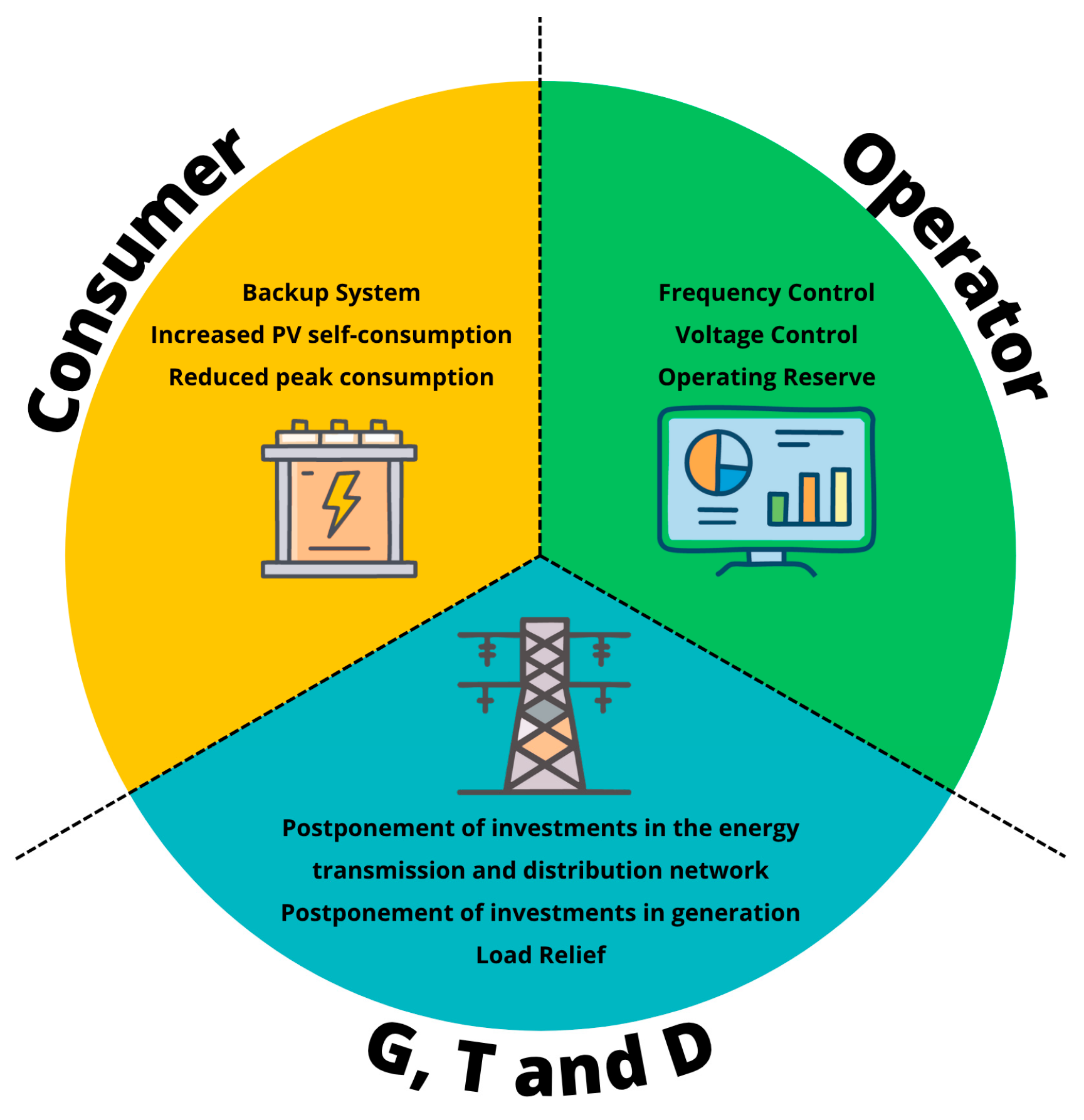
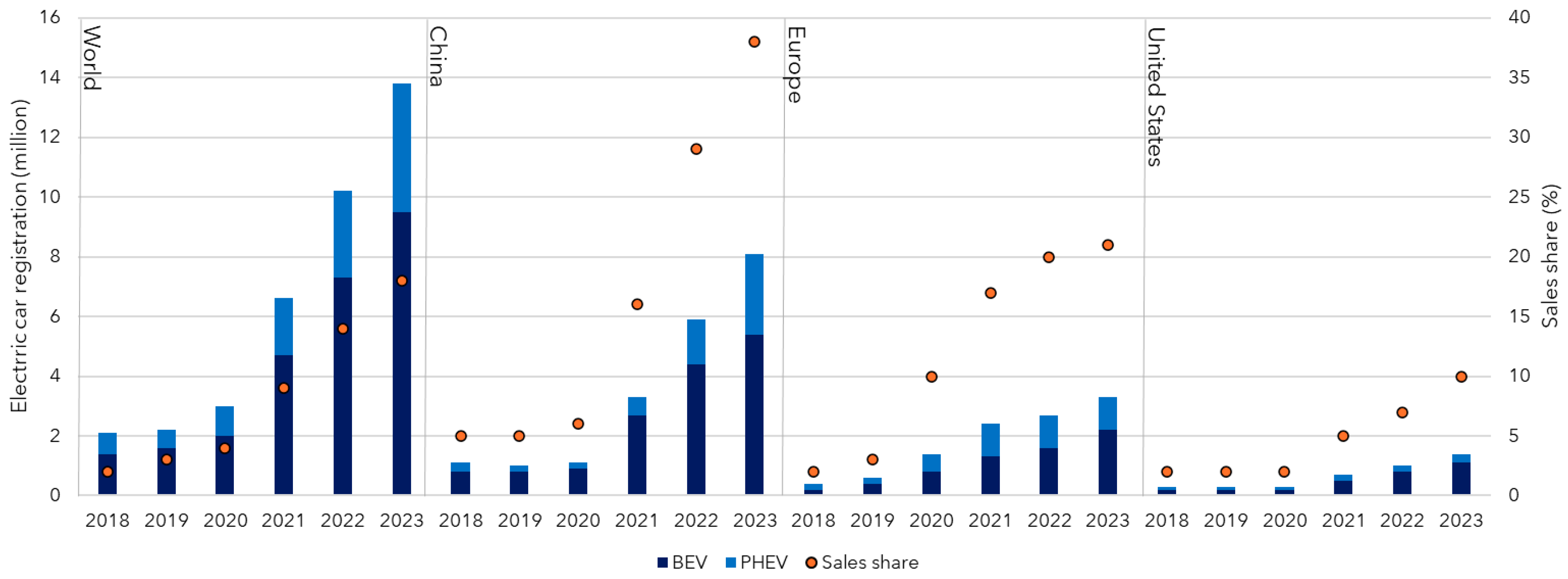

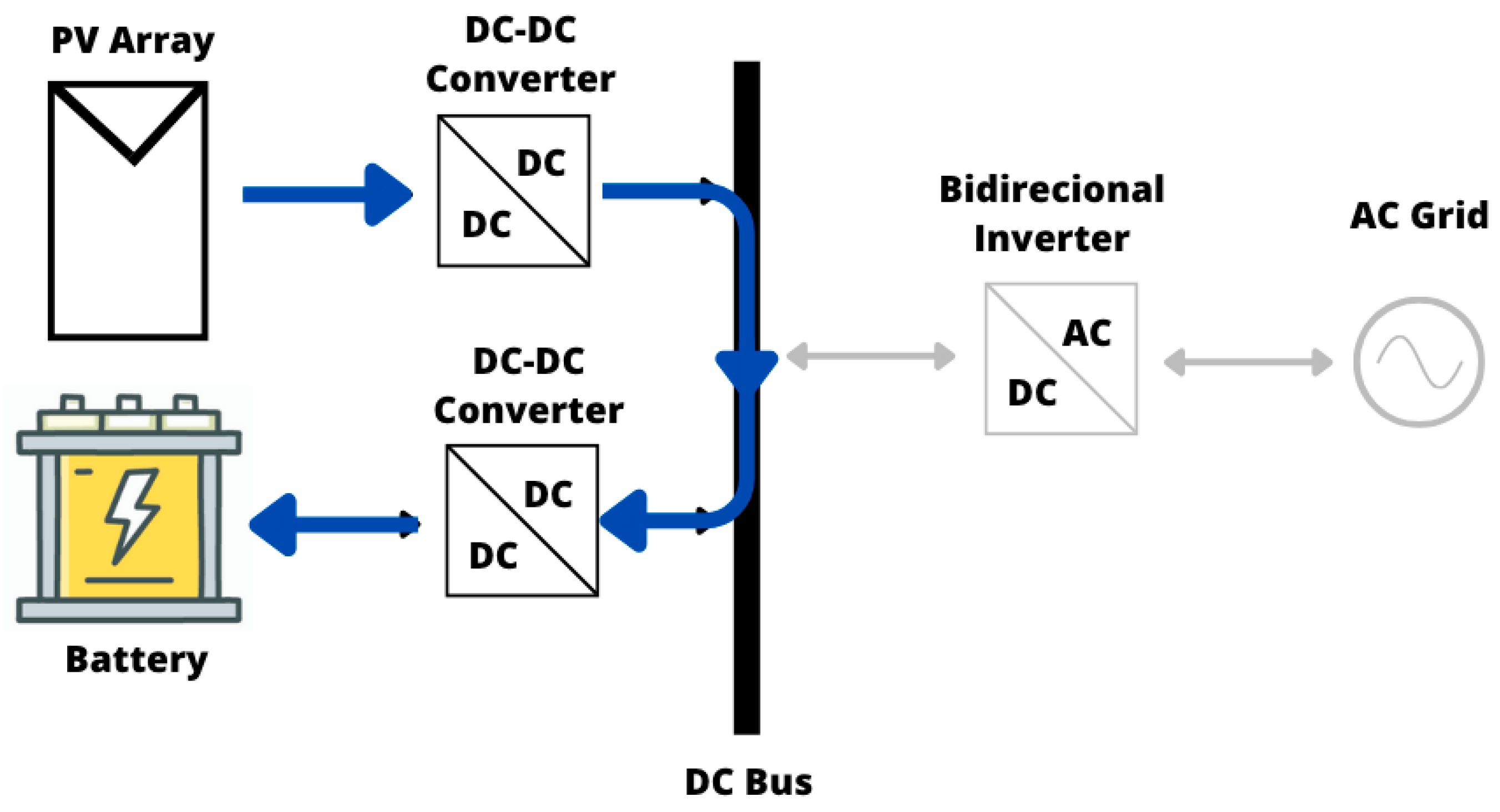
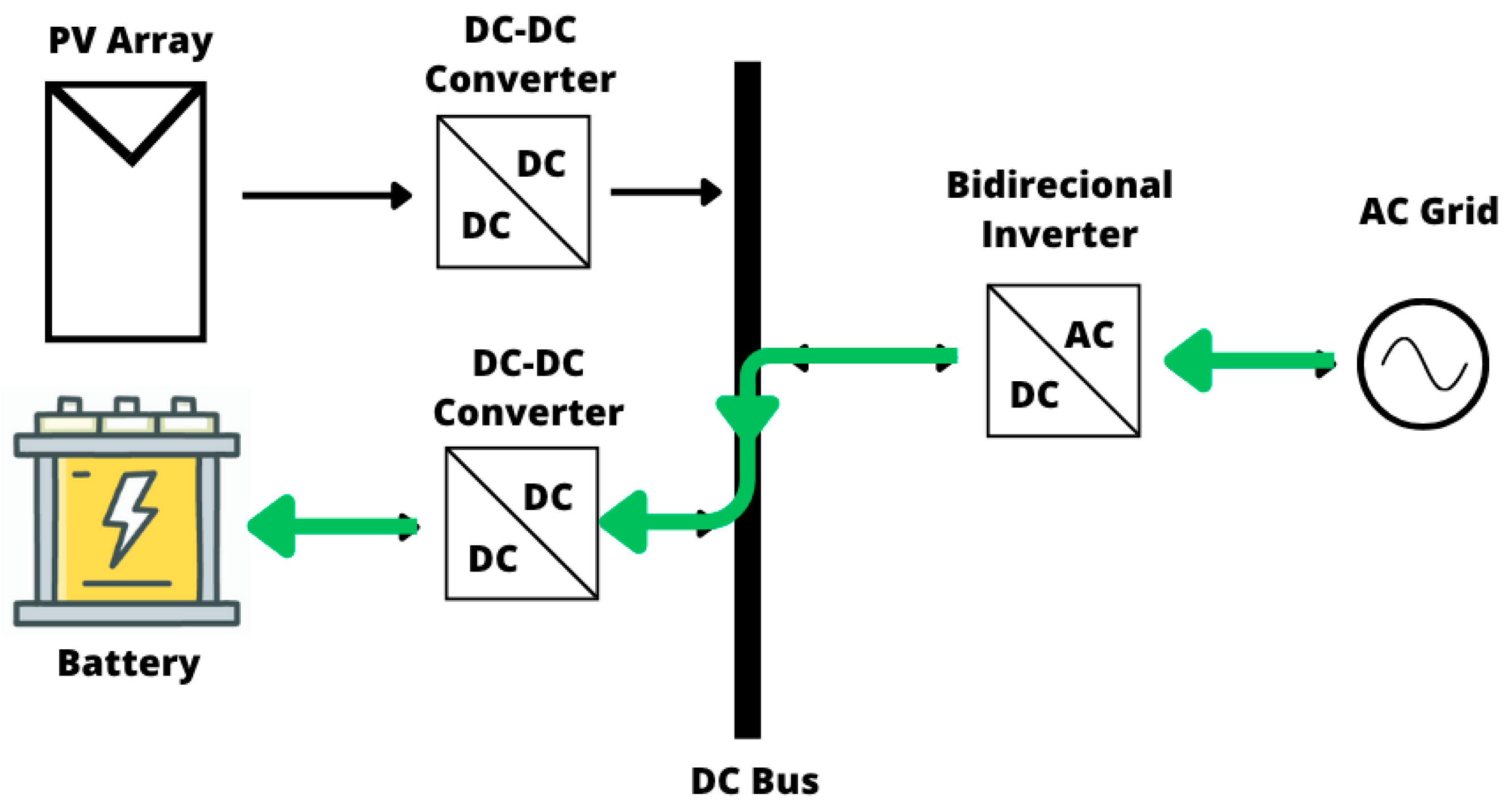
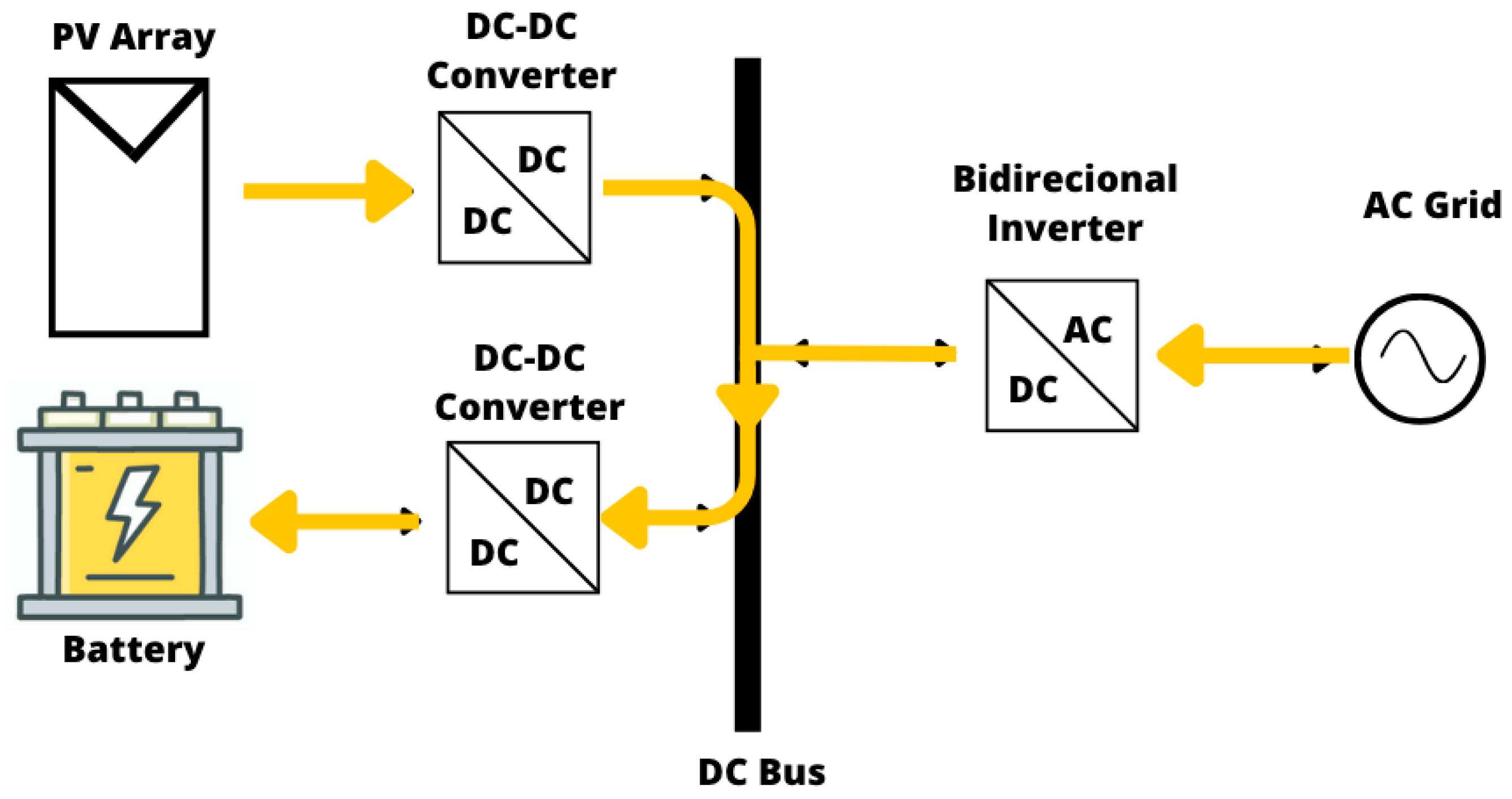
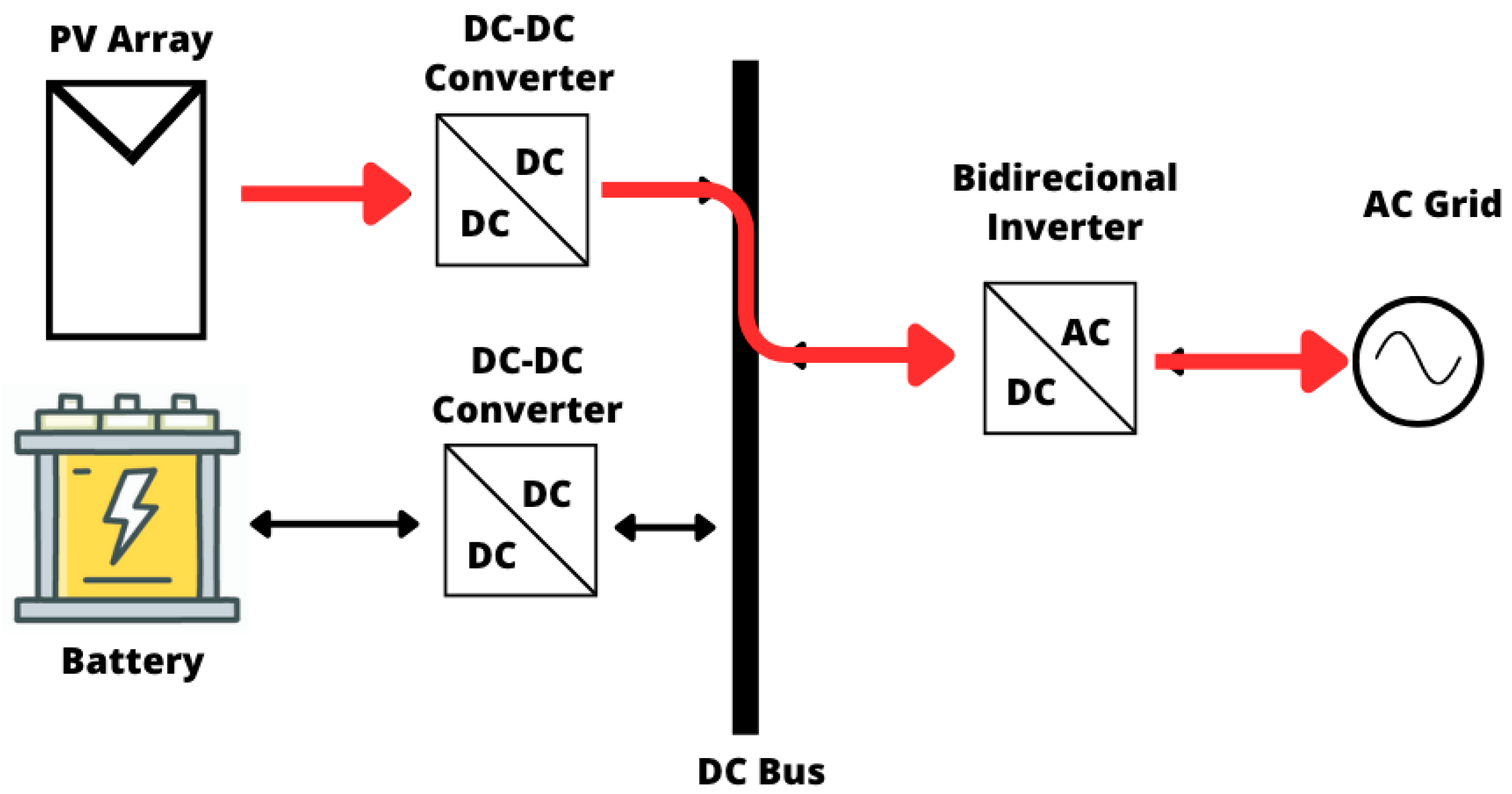
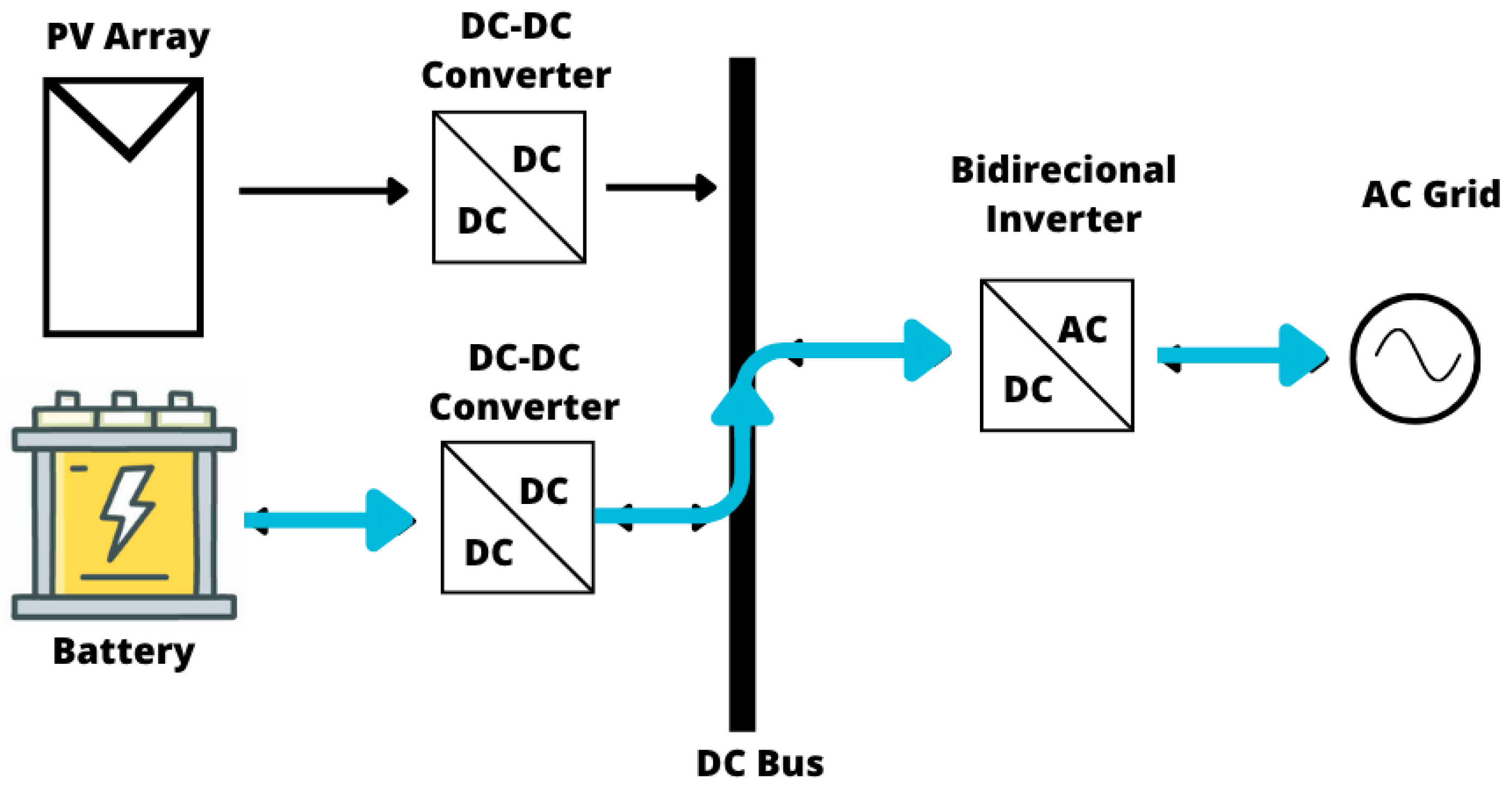
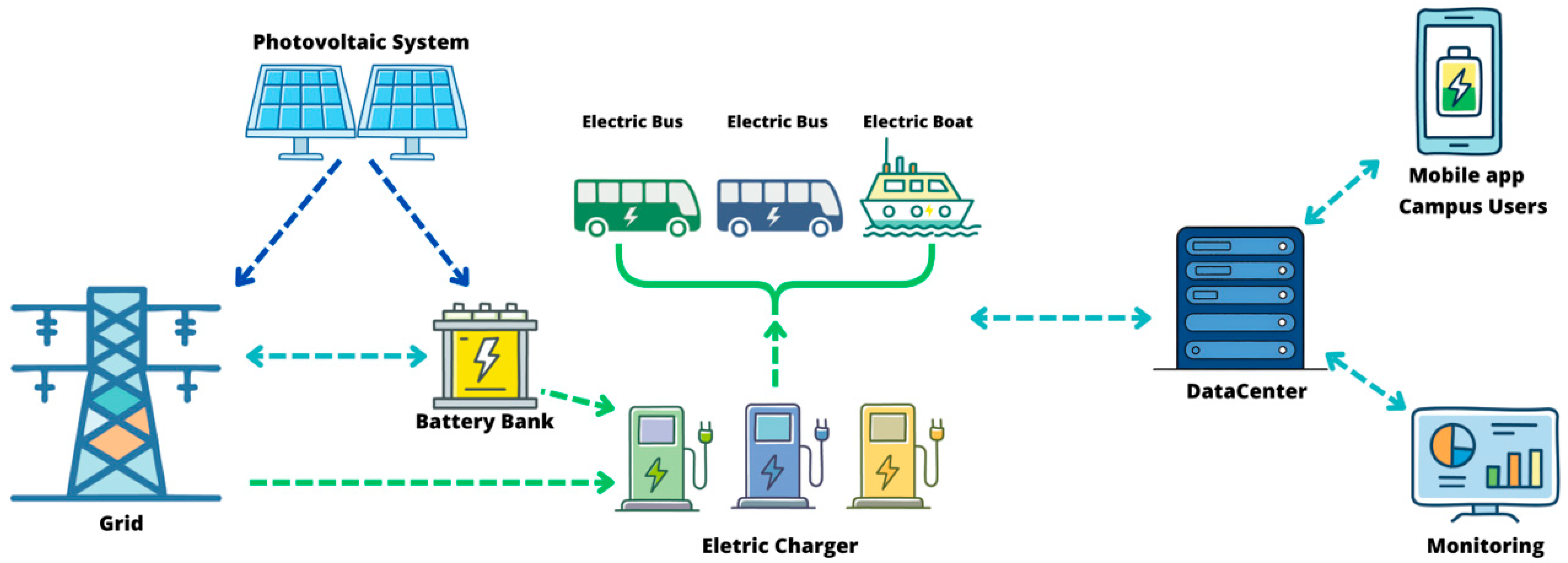


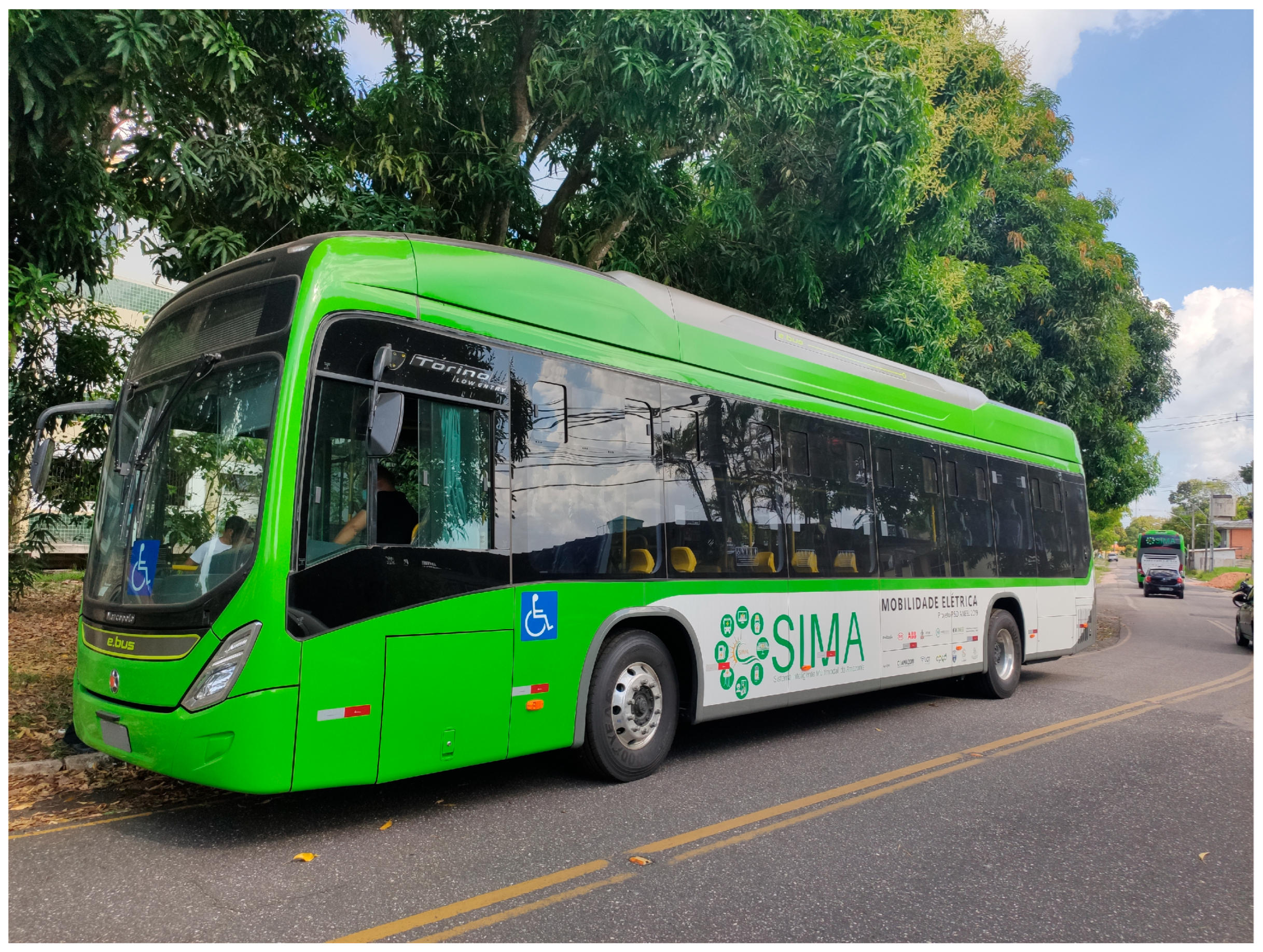
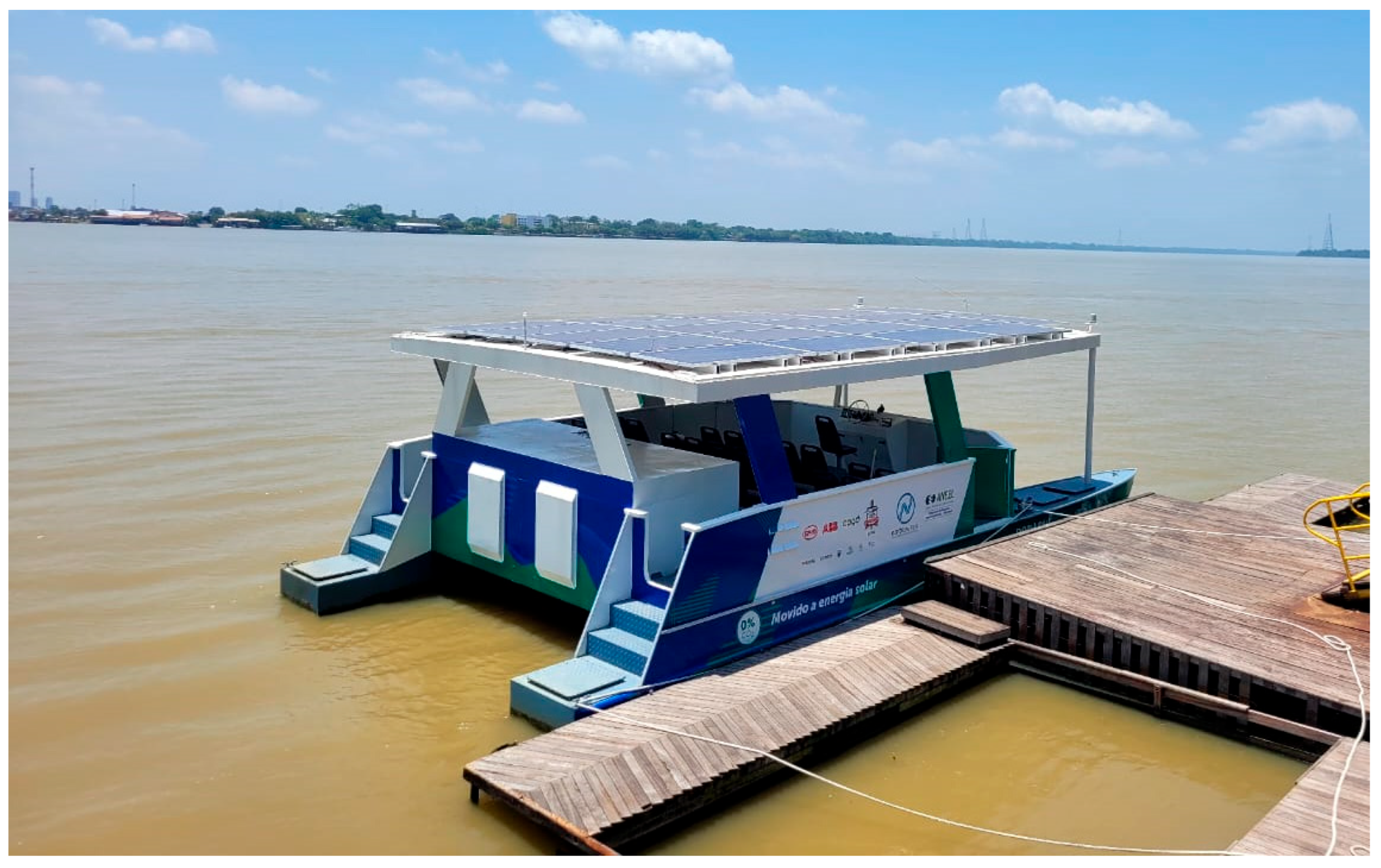

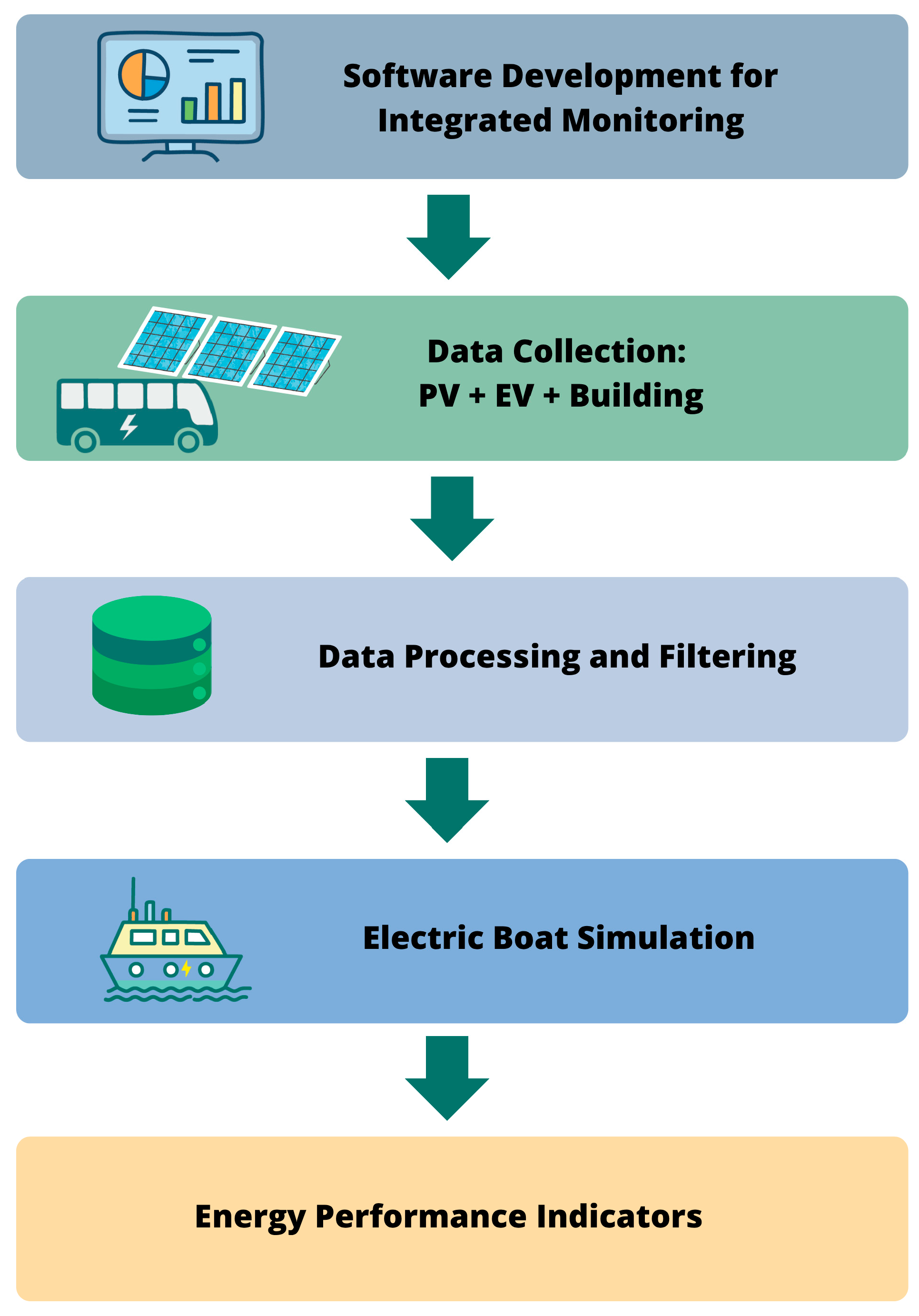
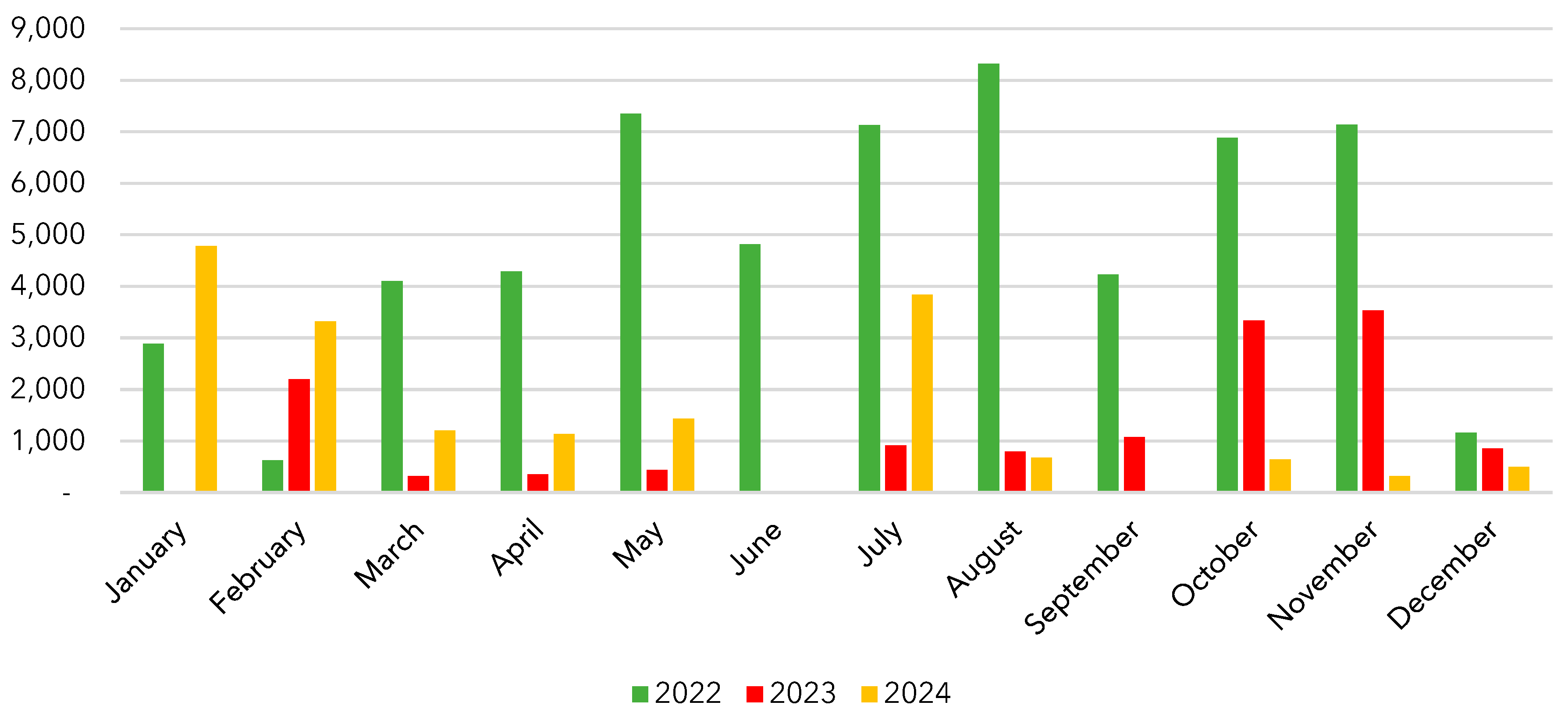


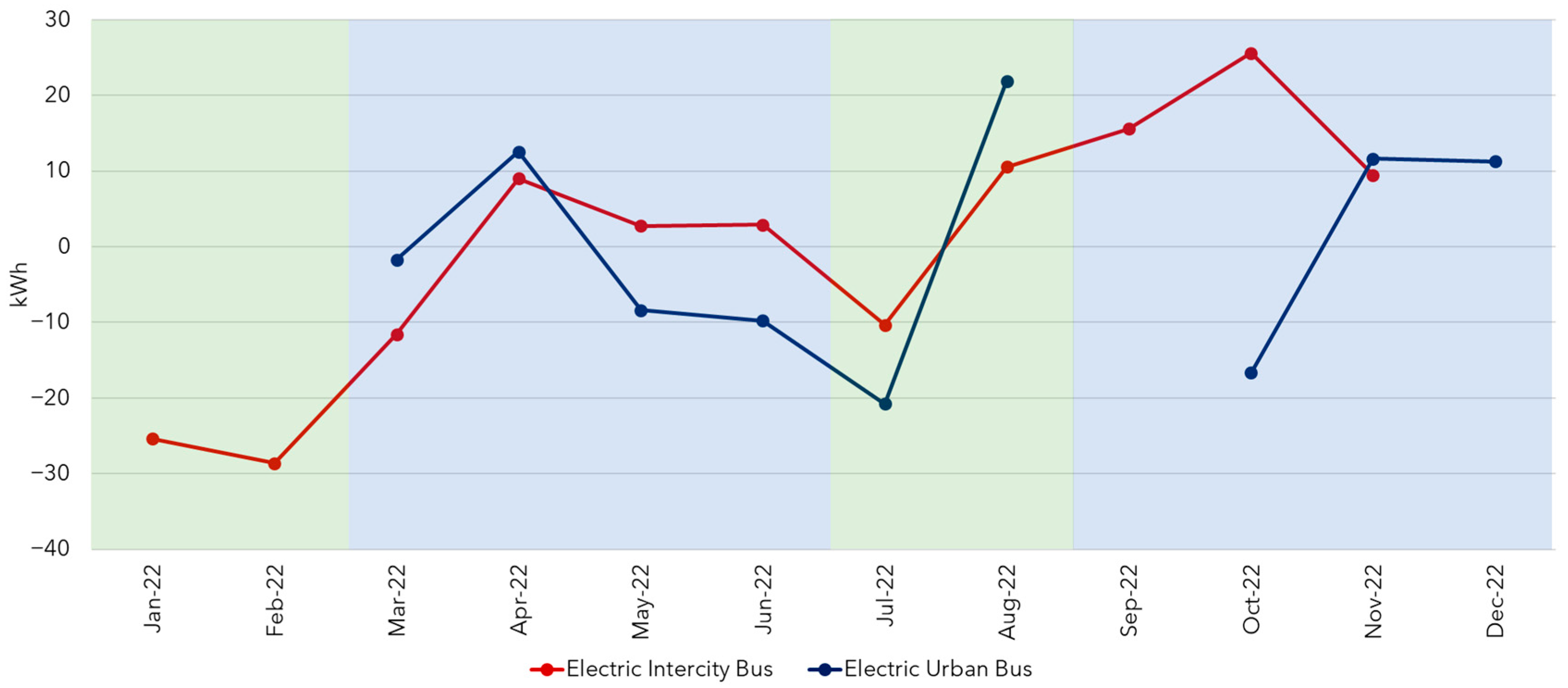

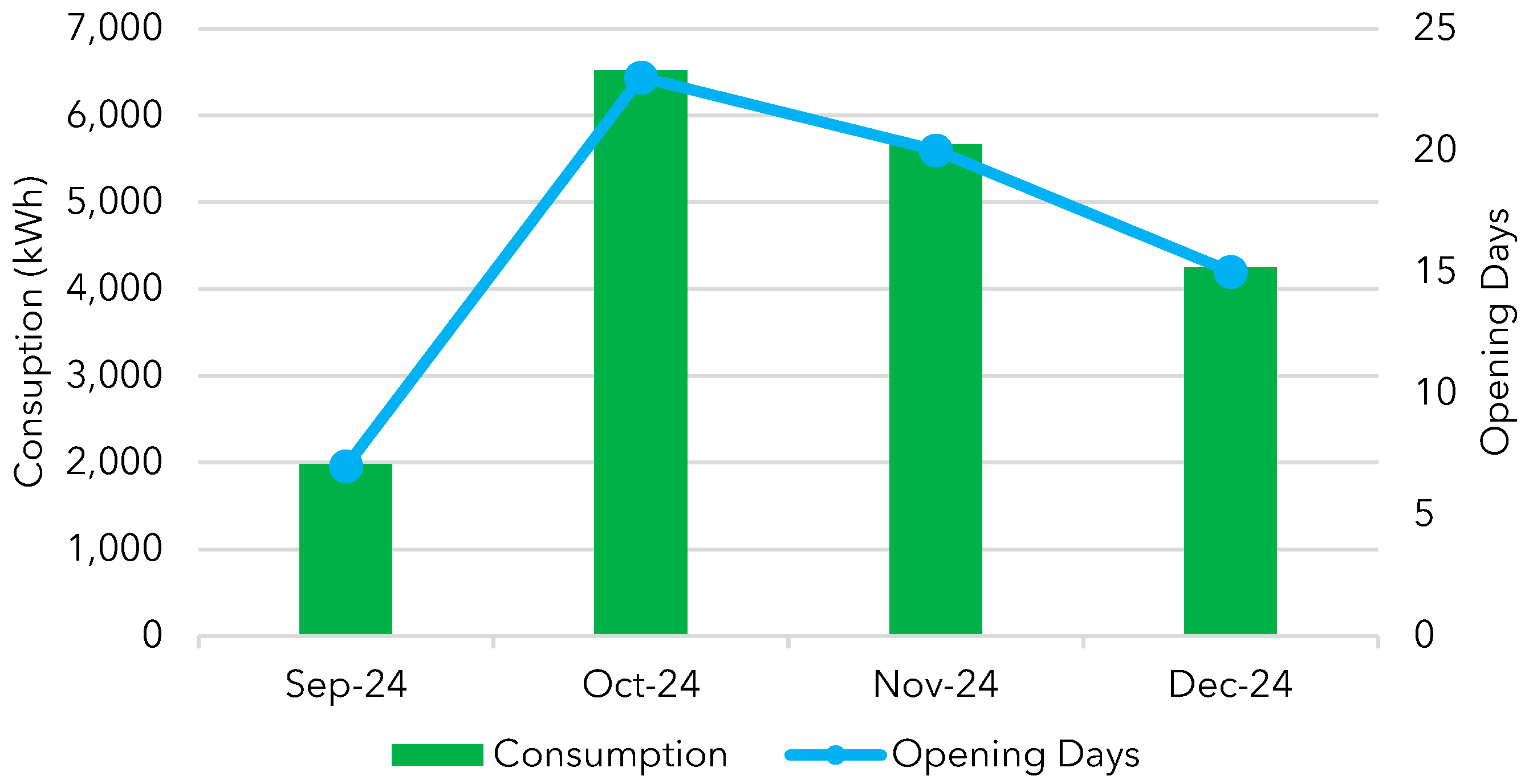


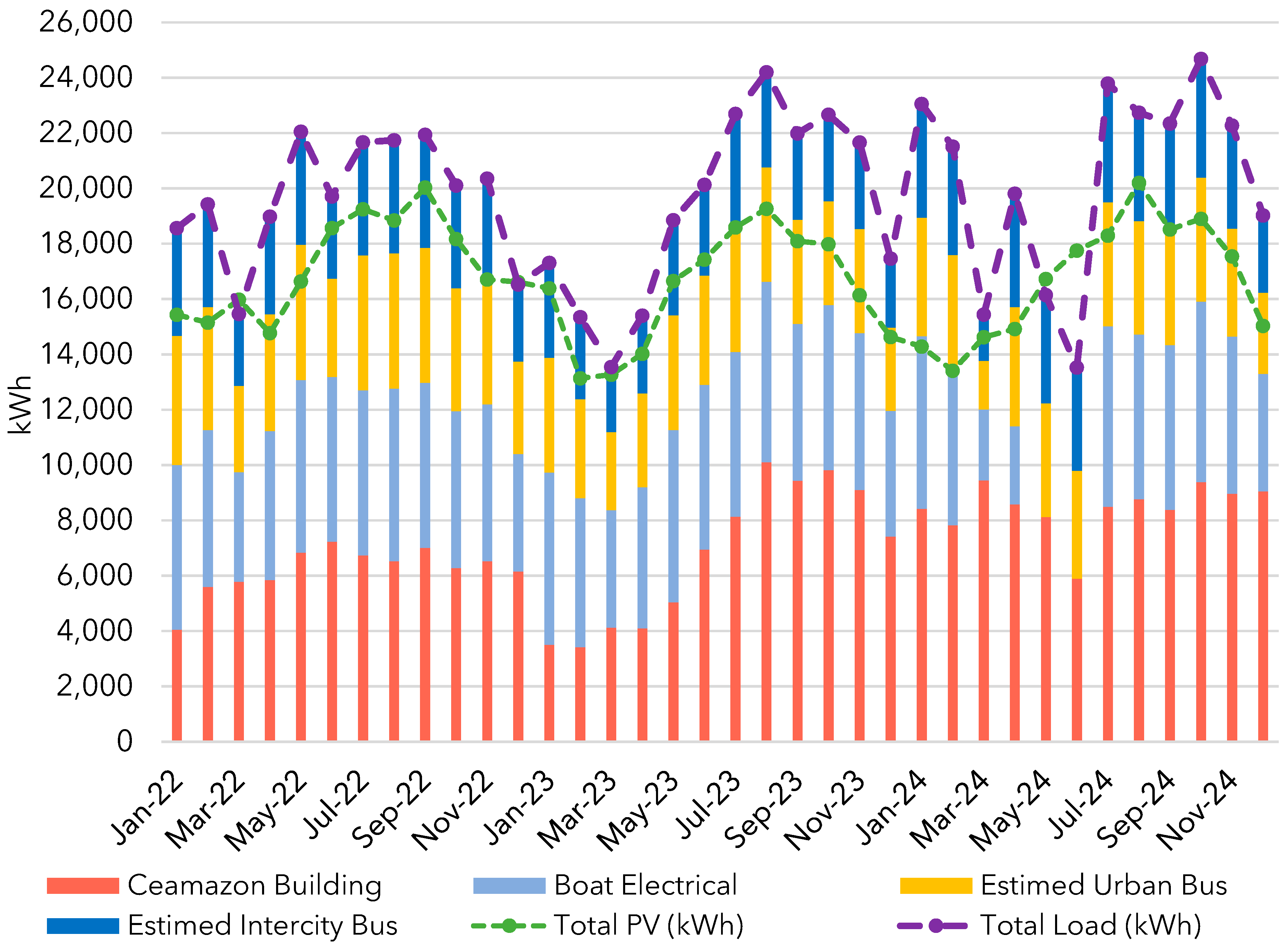
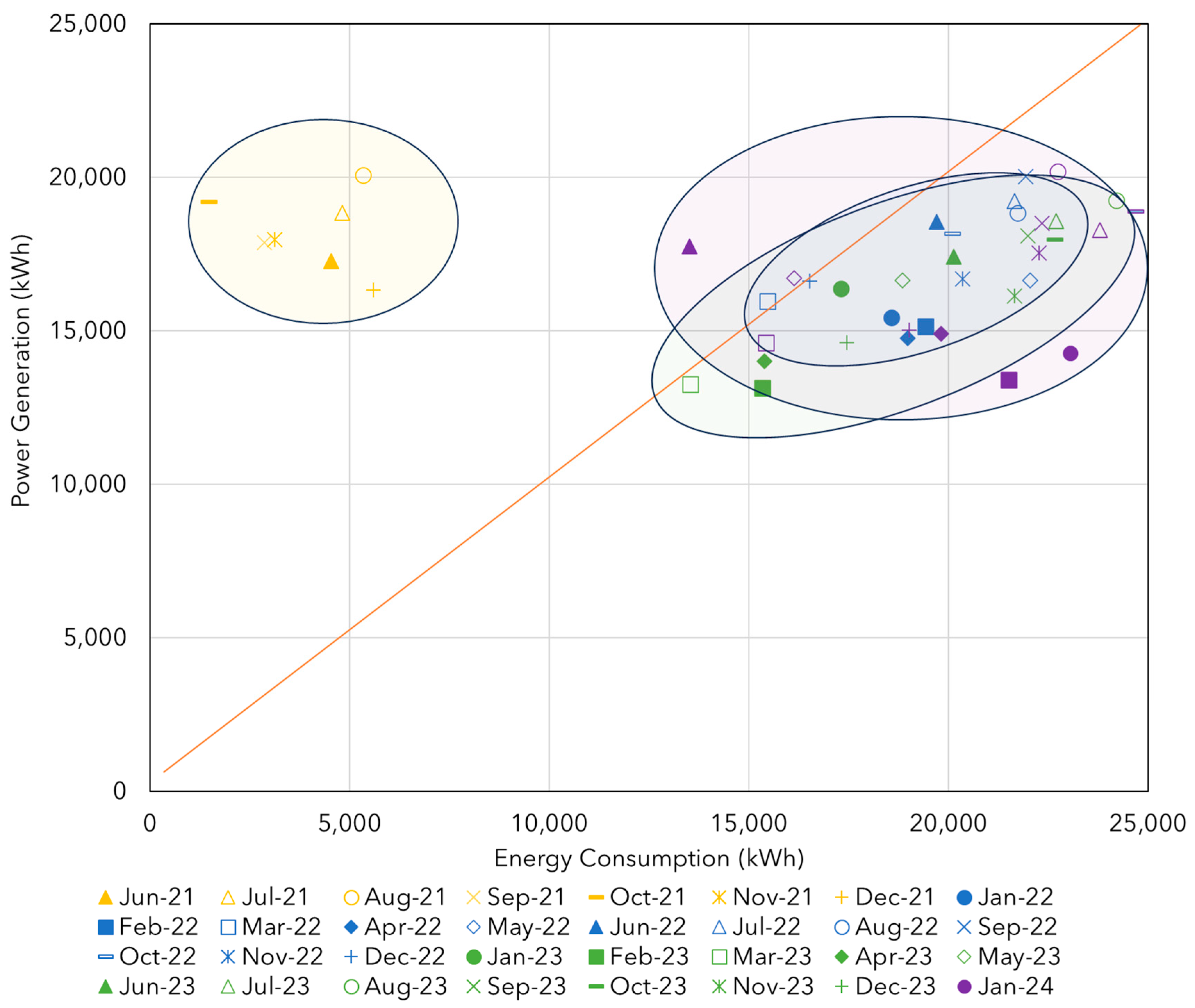
| Variables | Results and Interpretations |
|---|---|
| : Consumption is greater than generation. : Self-supply occurs : Generation is greater than consumption. | |
| : Photovoltaic surplus. : Monthly photovoltaic generation equals consumption. : Photovoltaic deficit. |
| Period | 2022 | 2023 | 2024 | |||||
|---|---|---|---|---|---|---|---|---|
| Extensive | Intensive | Extensive | Intensive | Extensive | Intensive | Date Overlap | Strike | |
| Urban | 65 | 36 | 53 | 20 | 16 | 31 | 15 | 5 |
| Intercity | 133 | 62 | 13 | 6 | 8 | 11 | 2 | 2 |
| Modal | 2022 | 2023 | 2024 | Average |
|---|---|---|---|---|
| Intercity bus | 0.82 | 0.76 | 0.75 | 0.7767 |
| Urban bus | 0.63 | 0.66 | 0.84 | 0.71 |
| Month | Operation (Days) | Estimated Consumption (kWh) |
|---|---|---|
| September/24 | 7 | 1983.66 |
| October/24 | 23 | 6517.74 |
| November/24 | 20 | 5667.60 |
| December/24 | 15 | 4250.70 |
Disclaimer/Publisher’s Note: The statements, opinions and data contained in all publications are solely those of the individual author(s) and contributor(s) and not of MDPI and/or the editor(s). MDPI and/or the editor(s) disclaim responsibility for any injury to people or property resulting from any ideas, methods, instructions or products referred to in the content. |
© 2025 by the authors. Licensee MDPI, Basel, Switzerland. This article is an open access article distributed under the terms and conditions of the Creative Commons Attribution (CC BY) license (https://creativecommons.org/licenses/by/4.0/).
Share and Cite
Santana de Albuquerque, B.; Lisboa do Nascimento, A.L.; de Lima Tostes, M.E.; Holanda Bezerra, U.; Moura de Moura Carvalho, C.C.; Muñoz Tabora, J. Net-Zero and Multimodal Mobility Project Through PV-Battery-EV in the Amazon. Energies 2025, 18, 6014. https://doi.org/10.3390/en18226014
Santana de Albuquerque B, Lisboa do Nascimento AL, de Lima Tostes ME, Holanda Bezerra U, Moura de Moura Carvalho CC, Muñoz Tabora J. Net-Zero and Multimodal Mobility Project Through PV-Battery-EV in the Amazon. Energies. 2025; 18(22):6014. https://doi.org/10.3390/en18226014
Chicago/Turabian StyleSantana de Albuquerque, Bruno, Ayrton Lucas Lisboa do Nascimento, Maria Emília de Lima Tostes, Ubiratan Holanda Bezerra, Carminda Célia Moura de Moura Carvalho, and Jonathan Muñoz Tabora. 2025. "Net-Zero and Multimodal Mobility Project Through PV-Battery-EV in the Amazon" Energies 18, no. 22: 6014. https://doi.org/10.3390/en18226014
APA StyleSantana de Albuquerque, B., Lisboa do Nascimento, A. L., de Lima Tostes, M. E., Holanda Bezerra, U., Moura de Moura Carvalho, C. C., & Muñoz Tabora, J. (2025). Net-Zero and Multimodal Mobility Project Through PV-Battery-EV in the Amazon. Energies, 18(22), 6014. https://doi.org/10.3390/en18226014






